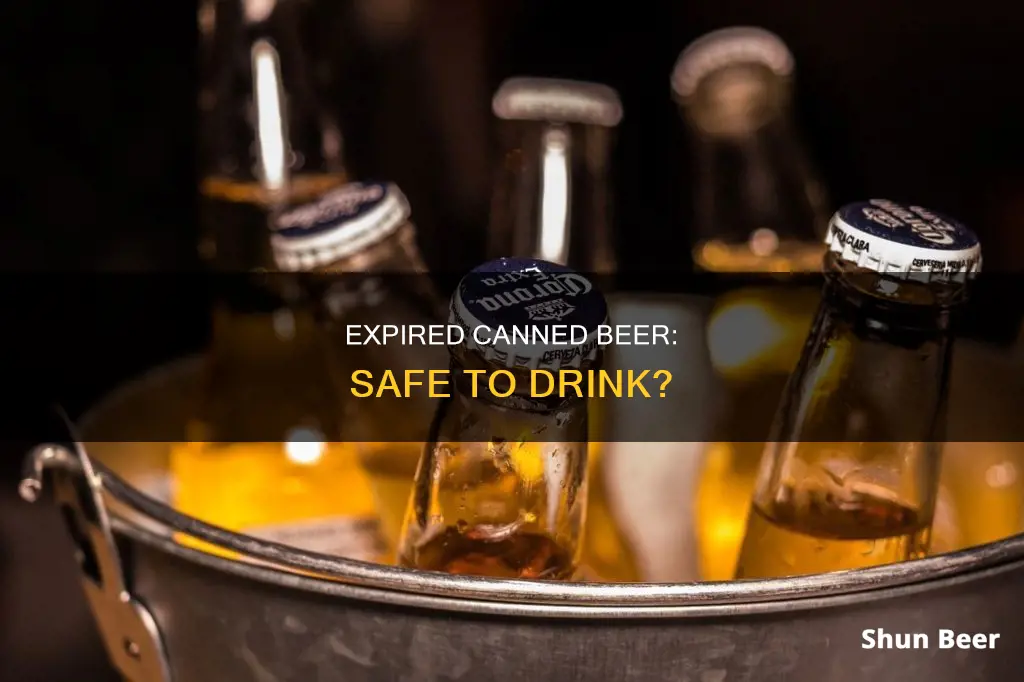
It's happened to the best of us: you find a can of beer at the back of the fridge and wonder, is it safe to drink? The short answer is yes, it's usually safe to drink expired canned beer. Beer is a perishable product that can go stale and change taste and smell over time due to exposure to light, oxygen, and heat, but it's unlikely to make you sick. This is because most beer is pasteurised or filtered to eliminate bacteria, and the fermentation process, low pH level, and alcohol content make it hard for microorganisms to survive. However, there are some rare situations where an old beer will need to be thrown out, such as if the seal is broken or if it has a vinegary taste, which indicates bacteria has gotten in.
| Characteristics | Values |
|---|---|
| Is it safe to drink expired canned beer? | Yes, but the flavour will degrade over time. |
| Why does the flavour degrade? | Beer is a perishable product that stales when exposed to light, oxygen, and heat, which break down the organic compounds that make beer smell and taste great. |
| How long does beer remain safe to drink? | Beer can remain safe to drink for several years if it is unopened and refrigerated. If stored at room temperature, it will only last four to six months. |
| What causes beer to go bad? | Oxidation and sunlight are the two main factors that cause beer to go bad. Direct sunlight can give beer a skunky smell. |
| How to prolong the life of beer? | Store beer in a cool, dark place, preferably a refrigerator. If storing at room temperature, keep it out of direct sunlight. |
What You'll Learn

Is drinking expired beer bad for your health?
It's happened to the best of us. You find a can of beer tucked away in the back of your fridge or pantry and wonder: is it safe to drink?
The short answer is yes, it's safe to drink expired beer. The fermentation process used in brewing, as well as its low pH level and alcohol content, make beer an unfriendly environment for microorganisms. Even if a beer sits on a shelf for years, as long as it's sealed, it's unlikely to make you sick.
However, there are a couple of situations where you'll need to throw out an old beer. If your beer has lost its fizz, it's a sign that the seal was broken and the flavour will be affected. If a beer that isn't meant to be tangy or acidic has a vinegary taste, it's an indication that bacteria has gotten in, and you should toss it out.
While drinking expired beer is fine for your health, the taste of beer does change over time. To enjoy beer at its best, it's recommended to buy it cold, store it in the fridge, and consume it within three to six months of packaging, or before its best-by date.
Beer is a perishable product that stales when exposed to light, oxygen, and heat, which degrade the organic compounds that make beer smell and taste great. However, even when its flavour is declining, it can still be safe to drink.
The "best by" or expiration date on beer indicates a timeframe when it will taste its best. Beer will still be safe to drink after these dates, but its flavour may be altered. Any beer bottle or can has a small amount of air in it, so as it ages, it will oxidize, which can change the flavour and body of the beer.
To prolong the life of your beer, store it in the fridge, ideally between 38 and 50 degrees Fahrenheit. When refrigerated, beer can last two to three years past its expiration date. At room temperature, it will only last four to six months.
So, if you find that old can of beer, don't worry—it's likely safe to drink, but be prepared for a change in taste.
The Art of Drinking Beer and Liquor
You may want to see also

What causes beer to expire?
Beer can expire, but it doesn't go bad in the same way that food does. It doesn't spoil and turn mouldy or grow colonies of mould, but it can lose its robust flavours over time.
There are several factors that contribute to beer expiration:
- Oxidation: When beer comes into contact with oxygen during the brewing process, packaging, or storage, it oxidises. This means that the oxygen reacts with the beer's chemical makeup, breaking down hop oils and other flavour compounds. This results in a cardboard-like or stale taste, a reduced aroma, and discolouration.
- Light Exposure: Beer, especially those in clear or green bottles, can become "skunky" when exposed to UV light. This is due to a photochemical reaction between UV light and hop compounds in the beer, resulting in a distinctive sulfur-like smell and a corresponding off-flavour.
- Microbial Contamination: While commercial beers are well-pasteurised and filtered, improper brewing practices, packaging errors, or poor storage conditions can lead to bacterial contamination. Unintended wild yeast infestations can also contaminate beer, especially in homebrews or improperly sealed commercial brews. This can result in a sour, musty, or metallic taste, and a cloudy appearance or unexpected sediment.
- Temperature Fluctuations: High temperatures accelerate chemical reactions that break down flavour compounds, leading to a stale or cooked taste. Freezing can cause the beer to expand, potentially breaking the container and introducing oxygen upon thawing, resulting in off-flavours. Temperature fluctuations can also affect the beer's carbonation, making it flat or overly fizzy.
Overall, the main culprits that can cause beer flavours to deteriorate are oxygen, heat, and light.
Chimp Beer Drinking: What's the Science Say?
You may want to see also

How to identify expired beer?
How to Identify Expired Beer:
Beer is just like any other food – it has a shelf life and can expire. However, it doesn't spoil in the same way as perishable foods. It won't grow mould or turn sour, but its taste and quality will deteriorate over time. Here are some ways to identify if your beer has expired:
- Check the packaging: Look for a "best before" or expiration date. Beer is best consumed within its shelf life, and even if it's safe to drink past this date, the taste may have declined.
- Listen for the hiss: When you open the beer, pay attention to the sound. If there's an absence of the signature hissing sound, it means the beer has lost its carbonation and gone flat.
- Inspect the foam: Fresh beer often produces white foam that rises to the top and spills over. If you don't see this, your beer may have gone flat.
- Check the label: If you're drinking from a bottle, inspect the label for dust, which could indicate that the beer has been sitting on the shelf for a while.
- Look for sediments: Hold the bottle up to the light and check for any sediments settled at the bottom. If you notice sediments, it's probably best to avoid drinking the beer. However, some beer styles, such as German Weissbier and Belgian Dubbel, are bottle-conditioned, so yeast sediments are not considered a flaw.
- Check for leakage: Look for any signs of leakage around the sealed mouth of the bottle, which may indicate that the beer has been subjected to high levels of heat.
- Smell and taste: If all else fails, use your senses of smell and taste. Expired beer may have "off" flavours and aromas, such as a skunky, sour, vinegary, metallic, musty, or cardboard-like taste or smell.
It's important to note that expired beer is typically not hazardous to consume. The worst thing that can happen is that it will taste bad. However, drinking expired beer is never recommended, as it will not provide the optimal drinking experience.
A Risky Mix: Beer and Benzonatate
You may want to see also

What is the difference between 'best before' and 'expiration' dates?
While the terms "best before" and "expiration date" may sound similar, they have distinct meanings that are crucial to understanding for the safety and quality of the products we consume.
A "best before" date indicates the end of a product's "durable life period", or the period in which the manufacturer guarantees the best quality, taste, nutritional value, or any other qualities claimed. After this date, the product can generally still be consumed, but its quality and taste may have diminished. For example, biscuits may lose their crispiness, or milk may undergo slight changes in taste.
An "expiration date", or "use by date", on the other hand, signifies the end of the recommended consumption period for a product. After this date, the product is considered unsafe to consume, as it may have spoiled or undergone chemical changes that could pose health risks. Consuming products past their expiration date can increase the risk of food poisoning, as bacteria such as Salmonella, E. coli, or Listeria may be present.
In the context of beer, it is important to note that the fermentation process, low pH level, and alcohol content make it resistant to spoiling. Even if a beer sits on the shelf for years, as long as it is sealed, it is unlikely to make you sick. However, the taste of beer can change over time, and it may lose its carbonation or develop a vinegary taste, indicating that bacteria have gotten in.
Drinking Beer While on Probation: What You Should Know
You may want to see also

How to store beer to extend its life?
Beer is a perishable product that can be safely consumed past its expiration date but will degrade in flavour over time. To extend its shelf life, it is important to understand the factors that cause beer to spoil and take the necessary precautions to prevent them. Here are some ways to store beer to extend its life:
Avoid Exposure to Light
Avoid exposing beer to sunlight or artificial light. Light, especially UV light, can cause a chemical reaction in the hops present in beer, creating a compound that smells and tastes like skunk spray. This process is known as "skunking" or "lightstrike". Beer is often packaged in dark bottles or aluminium cans to block out UV rays and reduce the risk of skunking. Clear and green glass bottles offer little to no protection against UV light, so it is best to avoid purchasing beer packaged in these containers.
Store Beer in a Cool, Dark Place
Heat speeds up the oxidation process, causing beer to age faster and negatively impact its flavour. The ideal storage temperature for beer depends on the type of beer and its intended serving temperature. As a general rule, beer should be stored at or slightly above its intended serving temperature. Lighter beers are best stored between 7°C and 10°C, while stronger beers should be stored between 12°C and 16°C. If you don't have access to a refrigerator, store beer in a cool, dark place, such as a basement or cellar, away from direct sunlight.
Reduce Exposure to Oxygen
Overexposure to oxygen can alter the taste of beer, causing oxidation and affecting the flavour compounds. Bottled beer is more susceptible to oxygen exposure than canned beer. To minimise oxygen exposure, store beer upright rather than on its side. This reduces the surface area exposed to oxygen and minimises contact with air. Additionally, try to minimise temperature fluctuations, as major changes in temperature can also impact the flavour of beer.
Store Beer Upright
In addition to reducing oxygen exposure, storing beer upright has other benefits. It helps prevent the formation of yeast rings or watermarks inside the bottle, which can influence the flavour of the beer. Storing beer upright also reduces the risk of leakage and ensures that any sediment settles at the bottom of the bottle, making it easier to pour a clear beer.
Other Considerations
- Always check the expiration date on the packaging and try to consume beer before its best-by date.
- Beer should be consumed as fresh as possible, especially hop-heavy styles like IPAs, as the delicate hop characteristics can dissipate over time.
- If you have a home-brewed beer, store it in a warm place during the final stage of fermentation, then move it to a cooler location for drinking.
- For opened beer, reseal it with an airtight cap or stopper to reduce oxidation and prevent carbonation loss.
Beer After a Workout: Good or Bad Idea?
You may want to see also
Frequently asked questions
Yes, it is safe to drink expired canned beer. Beer has a ''best before' date, indicating when it should be consumed to be enjoyed in a fresh state, but it does not have an 'expiration date'. Even if a beer sits on the shelf for years, as long as it is sealed, it is unlikely to make you sick.
The fermentation process used in brewing beer, as well as its low pH level and alcohol content, make beer an unfriendly environment for microorganisms.
If your beer has lost its fizz, that's a sign that the seal was broken at some point. If a beer that isn't supposed to be tangy has a vinegary taste, that's a sign that bacteria has gotten in.
To prolong the life of your beer, store it in a refrigerator between 38 and 50 degrees Fahrenheit. Avoid extreme heat, sunlight, and temperature fluctuations.







